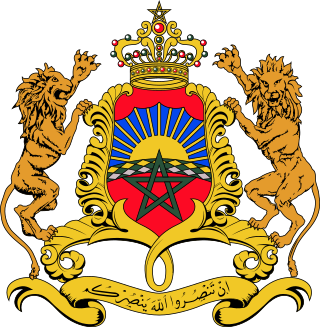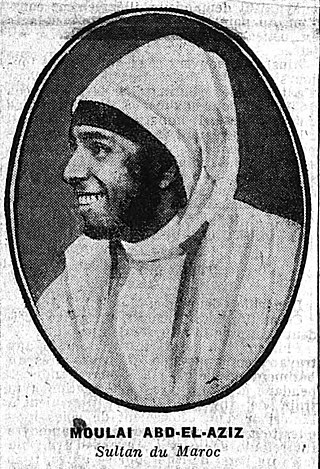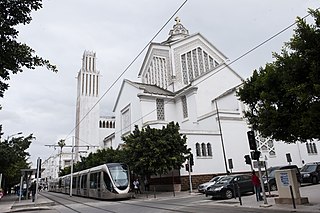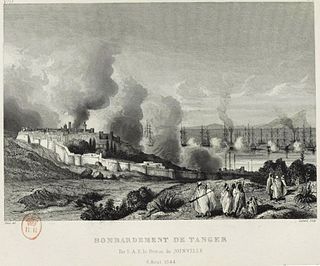
Moulay Ismail Ibn Sharif, born around 1645 in Sijilmassa and died on 22 March 1727 at Meknes, was a Sultan of Morocco from 1672 to 1727, as the second ruler of the 'Alawi dynasty. He was the seventh son of Moulay Sharif and was governor of the province of Fez and the north of Morocco from 1667 until the death of his half-brother, Sultan Moulay Rashid in 1672. He was proclaimed sultan at Fez, but spent several years in conflict with his nephew Moulay Ahmed ben Mehrez, who also claimed the throne, until the latter's death in 1687. Moulay Ismail's 55-year reign is the longest of any sultan of Morocco. During his lifetime, Isma’il amassed a harem of over 500 women with more than 800 confirmed biological children, making him one of the most prodigious fathers in recorded history.

Tangier or Tangiers is a city in northwestern Morocco, on the coasts of the Mediterranean Sea and the Atlantic Ocean. The city is the capital of the Tanger-Tetouan-Al Hoceima region, as well as the Tangier-Assilah Prefecture of Morocco.

Tétouan is a city in northern Morocco. It lies along the Martil Valley and is one of the two major ports of Morocco on the Mediterranean Sea, a few miles south of the Strait of Gibraltar, and about 60 kilometres (37 mi) E.S.E. of Tangier. In the 2014 Moroccan census, the city recorded a population of 380,787 inhabitants. It is part of the administrative division Tanger-Tetouan-Al Hoceima.

The 'Alawi dynasty – also rendered in English as Alaouite, 'Alawid, or Alawite – is the current Moroccan royal family and reigning dynasty. They are an Arab sharifian dynasty and claim descent from the Islamic prophet Muhammad through his grandson, Hasan ibn Ali. Their ancestors originally migrated to the Tafilalt region, in present-day Morocco, from Yanbu on the coast of the Hejaz in the 12th or 13th century.

The Spanish protectorate in Morocco was established on 27 November 1912 by a treaty between France and Spain that converted the Spanish sphere of influence in Morocco into a formal protectorate.

MoulayAbd al-Rahman bin Hisham was Sultan of Morocco from 30 November 1822 to 28 August 1859, as a ruler of the 'Alawi dynasty. He was a son of Moulay Hisham. He was proclaimed sultan in Fes after the death of Moulay Sulayman.

MoulayAbd al-Aziz bin Hassan, born on 24 February 1881 in Marrakesh and died on 10 June 1943 in Tangier, was a sultan of Morocco from 9 June 1894 to 21 August 1908, as a ruler of the 'Alawi dynasty. He was proclaimed sultan at the age of sixteen after the death of his father Hassan I. Moulay Abdelaziz tried to strengthen the central government by implementing a new tax on agriculture and livestock, a measure which was strongly opposed by sections of the society. This in turn led Abdelaziz to mortgage the customs revenues and to borrow heavily from the French, which was met with widespread revolt and a revolution that deposed him in 1908 in favor of his brother Abd al-Hafid.

MawlaySulayman bin Mohammed, born on 28 June 1766 in Tafilalt and died on 28 November 1822 in Marrakesh, was a Sultan of Morocco from 1792 to 1822, as a ruler of the 'Alawi dynasty. He was proclaimed sultan after the death of his half-brother al-Yazid. Sulayman continued his father's centralization and expansion of the kingdom, and most notably ended the piracy that had long operated from Morocco's coast. As part of Morocco's long running conflict with Spain and Portugal, Sulayman halted all trade with Europe. However, he continued his father's policies of close relations with the United States. He was also a follower of Wahhabism.
Sidi Mohammed ben Abdallahal-Khatib, known as Mohammed III, born in 1710 in Fes and died on 9 April 1790 in Meknes, was the Sultan of Morocco from 1757 to 1790 as a member of the 'Alawi dynasty. He was the governor of Marrakesh around 1750. He was also briefly sultan in 1748. He rebuilt many cities after the earthquake of 1755, including Mogador, Casablanca, and Rabat, and Abdallah Laroui described him as "the architect of modern Morocco." He also defeated the French in the Larache expedition in 1765 and expelled the Portuguese from Mazagan (al-Jadīda) in 1769. He is notable for having been the leader of one of the first nations to recognize American independence in his alliance with Luis de Unzaga 'le Conciliateur' through correspondence and Unzaga's secret intelligence service and led by his brothers-in-law Antonio and Matías de Gálvez from the Canary Islands. He was the son of Mawlay Abdallah bin Ismail and his wife a lady of the Chéraga guich tribe.
Mawlayal-Yazid bin Mohammed, born on 6 May 1750 in Fes and died on 23 February 1792 near Zagora, was a Sultan of Morocco from 1790 to 1792, a ruler of the 'Alawi dynasty. He was proclaimed sultan after the death of his father Mohammed bin Abdallah.

The Catholic Church in Morocco is part of the worldwide Catholic Church, under the spiritual leadership of the Pope in Rome. Catholics account less than 1% of the overall population of over 31 million. The country is divided into two archdioceses; Rabat and Tangier.

The Franco-Moroccan War was fought between the Kingdom of France and the Sultanate of Morocco from 6 August to 10 September 1844. The principal cause of war was the retreat of Algerian resistance leader Abd al-Kader into Morocco following French victories over many of his tribal supporters during the French conquest of Algeria and the refusal of the Sultan of Morocco Moulay Abd al-Rahman to abandon the cause of Abd al-Kader against colonial occupation.
The Hispano-Moroccan War, also known as the Spanish–Moroccan War, the First Moroccan War, the Tetuán War, or, in Spain, as the War of Africa, was fought from Spain's declaration of war on Morocco on 22 October 1859 until the Treaty of Wad-Ras on 26 April 1860. It began with a conflict over the borders of the Spanish city of Ceuta and was fought in northern Morocco. Morocco sued for peace after the Spanish victory at the Battle of Tetuán.

The Secretary of State for War, later Secretary of State, Minister for War, was one of the four or five specialized secretaries of state in France during the Ancien Régime. The position was responsible for the Army, for the Marshalcy and for overseeing French border provinces. In 1791, during the French Revolution, the Secretary of State for War became titled Minister of War.
Abu al-Abbas Ahmad ibn Ja'far al-Khazraji al-Sabti, better known as Sidi Bel Abbas, was a Moroccan Muslim saint. He is the patron saint of Marrakesh in the Islamic tradition and also one of the "Seven Saints" of the city. His festival was founded by al-Hasan al-Yusi at the instigation of Moulay Ismael.

The French conquest of Morocco began with the French Republic occupying the city of Oujda on 29 March 1907. The French launched campaigns against the Sultanate of Morocco which culminated in the signing of the Treaty of Fes and establishment of the French Protectorate in Morocco on 30 March 1912. France later concluded, on the 27th November, the Treaty of Madrid with the Kingdom of Spain which established the Spanish protectorate in Morocco. The French still conducted a series of military operations to pacify rebellions in Morocco until 1934.
Abu Zakariya Yahya ibn Ziyan al-Wattasi (abū zakarīyā' yaḥyā ben ziyān al-waṭṭāsī Arabic: أبو زكرياء يحيى بن زيان الوطاس was a vizier of the Marinid sultan of Fez, regent and effective strongman ruler of Morocco from 1420 until 1448. He is the founder of the Wattasid dynasty of viziers and later sultans, and as such often designated as Yahya I in Wattasid lists. He was also known by his nickname Lazeraque, as found in Portuguese chronicles.

The sieges of Ceuta, also known as the thirty-year siege, were a series of blockades by Moroccan forces of the Spanish-held city of Ceuta on the North African coast. The first siege began on 23 October 1694 and finished in 1720 when reinforcements arrived. During the 26 years of the first siege, the city underwent changes leading to the loss of its Portuguese character. While most of the military operations took place around the city walls, there were also small-scale penetrations by Spanish forces at various points on the Moroccan coast, and the seizure of shipping in the Strait of Gibraltar. The city was placed under a second siege in 1721 until 22 April 1727. The engagements are considered to be the longest siege in history.

The siege of Ceuta (1790–1791) was an armed confrontation between the Kingdom of Spain and the Sultanate of Morocco during the Spanish-Moroccan War of 1790–1791. The siege of this city was the central episode of this conflict.
The siege of Oran (1693) was an attempt by the Alaouite sultan Ismail Ibn Sharif to take the city of Oran, which was then under Spanish rule. After being defeated by the Spanish, he was attacked and defeated again by the Algerian Arab tribes while retreating from the territory.













